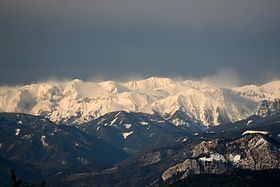Peak Hochschwab Length 40 km (25 mi) Highest point Hochschwab | Elevation 2,277 m (7,470 ft) Country Austria Mountains Hochschwab, Messnerin | |
 | ||
Similar Ebenstein, Brandstein, Schneealpe, Messnerin, Schneeberg | ||
Austria s green lake in the hochschwab mountains
The Hochschwab, Hochschwab Mountains, Hochschwab Alps or Hochschwab Group (German: Hochschwabgruppe) is a mountain range in the Northern Limestone Alps of Austria. The range is in the Styria. The highest peak is also called Hochschwab and is 2,277 metres above the Adriatic.
Contents
- Austria s green lake in the hochschwab mountains
- Map of Hochschwab 8621 Sankt Ilgen Austria
- Location
- Alpine huts
- Significant peaks
- Literature
- References
Map of Hochschwab, 8621 Sankt Ilgen, Austria
Location
The mountain range is located in the eastern part of the Northern Alps in the Austrian state of Styria.
According to the Alpine Club classification of the Eastern Alps (AVE) the range is bounded as follows:
Großreifling – Salza – Gußwerk – Wegscheid – Seeberg Saddle – Seegraben – Stübmingbach – Thörlbach to its confluence with the Mürz – Mürz to its confluence with the Mur – Mur to Leoben – Vordernberger Bach – Präbichl – Erzbach – Hieflau – Enns to GroßreiflingIt includes:
The extensive limestone plateau covers an area of about 400 km² and is bounded in the east by the Seeberg Saddle and in the west by the Präbichl. Only this massif belongs to the high limestone peaks of the Northern Limestone Alps.
Customarily only the limestone alpine region is described as the Hochschwab Group. The area classified systematically by the Alpine Clubs as the southern parts (along the significant orographic line of the valley), which have a completely different appearance, are known hereabouts as the Mürzsteg Alps or Mürz Hills (Mürzberge).
